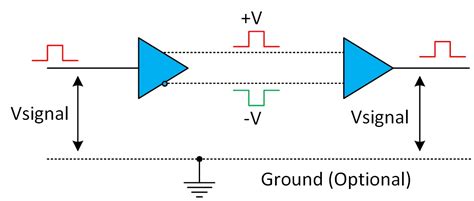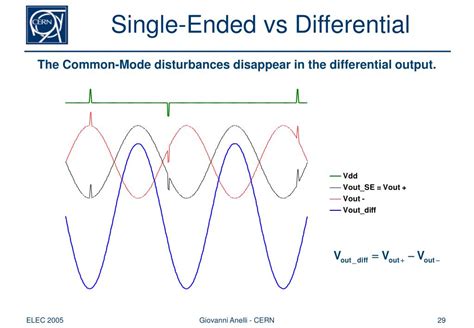What is Single-Ended Signaling?
Single-ended signaling is a method of transmitting electrical signals over a single wire or trace, with the voltage referenced to a common ground. In a single-ended system, the voltage level of the signal is measured with respect to the ground reference. Single-ended signaling is a simple and cost-effective method of signal transmission, widely used in many electronic systems.
Advantages of Single-Ended Signaling
- Simplicity: Single-ended signaling is easy to implement and requires fewer components compared to differential signaling.
- Lower cost: Due to its simplicity and fewer required components, single-ended signaling is generally more cost-effective than differential signaling.
- Compatibility: Many electronic devices and systems are designed to work with single-ended signaling, making it a widely compatible signaling method.
Disadvantages of Single-Ended Signaling
- Noise susceptibility: Single-ended signals are more vulnerable to noise, as the signal and noise share the same reference (ground). This can lead to signal integrity issues, especially in high-speed or long-distance transmissions.
- Limited bandwidth: Single-ended signaling has a lower bandwidth compared to differential signaling, limiting its use in high-speed applications.
- Electromagnetic interference (EMI): Single-ended signals can generate more EMI, which can interfere with nearby electronic devices and cause compliance issues with electromagnetic compatibility (EMC) regulations.
What is Differential Signaling?
Differential signaling is a method of transmitting electrical signals using two complementary signals sent over a pair of wires or traces. The information is conveyed by the difference in voltage between the two signals, rather than the absolute voltage level with respect to a common ground. This makes differential signaling more resistant to noise and interference compared to single-ended signaling.
Advantages of Differential Signaling
- Noise immunity: Differential signaling is less susceptible to noise because any noise induced on the signal pair affects both wires equally, canceling out the noise when the difference between the signals is measured at the receiver.
- Higher bandwidth: Differential signaling can achieve higher data rates and greater bandwidth compared to single-ended signaling, making it suitable for high-speed applications.
- Reduced EMI: Differential signals generate less EMI due to the cancellation of electromagnetic fields, as the currents in the two wires flow in opposite directions.
Disadvantages of Differential Signaling
- Complexity: Differential signaling requires more complex circuitry and components compared to single-ended signaling, including dedicated differential drivers and receivers.
- Higher cost: The increased complexity and component count of differential signaling systems can result in higher costs compared to single-ended signaling.
- Increased power consumption: Differential signaling systems generally consume more power than single-ended systems due to the additional components and circuitry required.

Comparing Single-Ended and Differential Signaling
The following table summarizes the key differences between single-ended and differential signaling:
| Characteristic | Single-Ended Signaling | Differential Signaling |
|---|---|---|
| Signal transmission | Over a single wire or trace | Over a pair of wires or traces |
| Noise immunity | Low | High |
| Bandwidth | Limited | Higher |
| EMI generation | Higher | Lower |
| Complexity | Simple | More complex |
| Cost | Lower | Higher |
| Power consumption | Lower | Higher |

Applications of Single-Ended and Differential Signaling
Single-Ended Signaling Applications
- Low-speed interfaces: Single-ended signaling is commonly used in low-speed interfaces such as I2C, SPI, and UART, where noise and bandwidth requirements are less demanding.
- Analog signals: Many analog signals, such as audio and sensor outputs, are transmitted using single-ended signaling.
- Legacy systems: Older electronic systems and devices often rely on single-ended signaling due to its simplicity and compatibility with existing designs.
Differential Signaling Applications
- High-speed interfaces: Differential signaling is widely used in high-speed interfaces like USB, PCIe, HDMI, and Ethernet, where noise immunity and bandwidth are critical.
- Long-distance transmission: Differential signaling is preferred for long-distance signal transmission, as it maintains signal integrity over greater distances compared to single-ended signaling.
- Noisy environments: In environments with high levels of electromagnetic noise, differential signaling provides better signal quality and reliability.

Design Considerations for Single-Ended and Differential Signaling
When choosing between single-ended and differential signaling for a specific application, designers should consider the following factors:
- Speed and bandwidth requirements: If high data rates and bandwidth are needed, differential signaling is often the better choice.
- Noise and interference: In noisy environments or when signal integrity is crucial, differential signaling provides better noise immunity and signal quality.
- Distance: For long-distance signal transmission, differential signaling maintains signal integrity over greater distances compared to single-ended signaling.
- Cost and complexity: Single-ended signaling is generally simpler and more cost-effective, while differential signaling requires more complex circuitry and components, resulting in higher costs.
- Power consumption: Single-ended signaling typically consumes less power than differential signaling due to its simpler design and fewer components.
- EMI and EMC compliance: Differential signaling generates less EMI, making it easier to comply with EMC regulations in sensitive applications.
Frequently Asked Questions (FAQ)
-
Q: Can single-ended and differential signaling be used together in the same system?
A: Yes, it is possible to use both single-ended and differential signaling in the same system, depending on the specific requirements of each signal or interface. However, care must be taken to ensure proper signal integrity and to avoid any potential issues caused by mixing the two signaling methods. -
Q: What is the main advantage of differential signaling over single-ended signaling?
A: The main advantage of differential signaling is its superior noise immunity compared to single-ended signaling. By using two complementary signals, differential signaling can cancel out common-mode noise, resulting in better signal integrity and reliability, especially in noisy environments or for long-distance transmissions. -
Q: Why is single-ended signaling still used despite its limitations?
A: Single-ended signaling remains in use due to its simplicity, lower cost, and compatibility with many existing electronic devices and systems. In applications where noise, bandwidth, and distance requirements are less demanding, single-ended signaling can be a cost-effective and practical choice. -
Q: What is the impact of signal integrity on system performance?
A: Signal integrity is crucial for ensuring the correct operation and performance of electronic systems. Poor signal integrity can lead to data errors, reduced bandwidth, and even complete system failure. By choosing the appropriate signaling method and implementing proper design techniques, designers can maintain signal integrity and optimize system performance. -
Q: How can I determine whether to use single-ended or differential signaling for my application?
A: The choice between single-ended and differential signaling depends on several factors, including speed and bandwidth requirements, noise and interference levels, transmission distance, cost and complexity constraints, power consumption, and EMI/EMC compliance. Analyze your specific application requirements and consider the trade-offs between the two signaling methods to make an informed decision.
Conclusion
Single-ended and differential signaling are two fundamental methods for transmitting electrical signals in electronic systems. Single-ended signaling offers simplicity and lower cost but is more susceptible to noise and has limited bandwidth. In contrast, differential signaling provides superior noise immunity and higher bandwidth but comes with increased complexity and cost.
When designing electronic systems, it is essential to carefully consider the specific requirements of the application, such as speed, noise, distance, cost, and power consumption, to choose the most appropriate signaling method. By understanding the strengths and limitations of single-ended and differential signaling, designers can make informed decisions and optimize system performance while meeting the desired constraints.
As technology continues to advance and the demand for high-speed, reliable, and efficient electronic systems grows, the choice between single-ended and differential signaling will remain an important consideration for designers across various industries and applications.

No responses yet